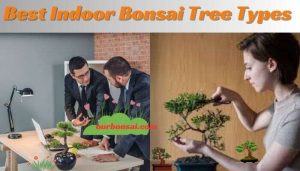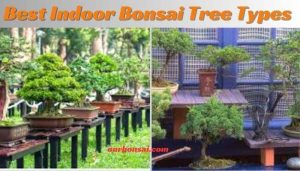Discover the best indoor bonsai tree types perfect for your home or office. From low-maintenance options to stunning decorative varieties, explore the top choices for beginners and experts. Find the ideal indoor bonsai to enhance your space with beauty and tranquility.
Table of Contents
ToggleBonsai trees bring nature into your home in a beautiful way. They are small, artistic, and easy to care for.
If you’re looking to add a touch of green indoors, bonsai trees are a perfect choice. These miniature trees can thrive inside with the right care. They offer a unique blend of art and nature, making them a great addition to any home.
But with so many types available, it can be challenging to pick the right one. In this guide, we will explore the best indoor bonsai tree types.
Whether you’re a beginner or an experienced gardener, you’ll find something that suits your needs and style. Get ready to transform your living space with these stunning indoor bonsai trees!

Best Indoor Bonsai Tree Types
Explore the beauty of indoor bonsai trees with options like the Ficus, Chinese Elm, and Jade. These types thrive indoors, offering low-maintenance greenery for any space. Perfect for beginners, they bring nature closer to home.
Growing indoor bonsai trees can be a delightful hobby. They add a touch of nature to your home and are relatively easy to care for. Let’s explore some of the best indoor bonsai tree types that you can enjoy.
Ficus Bonsai
Ficus bonsai trees are popular for indoor settings.
- Hardy and adaptable: They can thrive in low light.
- Easy to shape: Their flexible branches are simple to train.
- Air-purifying qualities: Ficus trees improve indoor air quality.
Jade Bonsai
Jade bonsai trees are known for their unique appearance.
Their thick, oval leaves and strong branches make them a standout choice. These trees are drought-tolerant and need very little water. They also grow well in bright light and dry conditions.
Chinese Elm Bonsai
Chinese Elm bonsai trees are beloved by many.
- Beautiful bark: The smooth, mottled bark is quite striking.
- Fine leaves: They have small, delicate leaves.
- Resilient nature: These trees are forgiving and easy to care for.
Dwarf Schefflera Bonsai | Best Indoor Bonsai Tree Types
Dwarf Schefflera bonsai trees are visually appealing.
They feature umbrella-like leaves and are perfect for beginners. These trees can adapt to various light conditions and are quite hardy.

Hawaiian Umbrella Bonsai
Hawaiian Umbrella bonsai trees are stunning.
- Compact growth: They don’t take up much space.
- Easy maintenance: They need minimal pruning.
- Versatile placement: These trees thrive in different indoor spots.
Serissa Bonsai
Serissa bonsai trees are also called ‘Tree of a Thousand Stars’.
Their tiny, white flowers bloom throughout the year. These trees prefer bright light and well-drained soil. They are a bit more challenging but very rewarding.
Fukien Tea Bonsai
Fukien Tea bonsai trees are charming.
- Glossy leaves: Their leaves are shiny and dense.
- Year-round blooms: They produce small, white flowers often.
- Fruit-bearing: They can grow tiny red berries.
Sago Palm Bonsai | Best Indoor Bonsai Tree Types
Sago Palm bonsai trees offer a unique look.
These trees resemble miniature palms, with their feathery fronds. They are slow-growing and need bright, indirect light. Sago Palms are also quite durable and can live for many years.
Money Tree Bonsai
Money Tree bonsai trees are believed to bring good fortune.
- Braided trunks: They often have interwoven trunks.
- Hardy plants: They thrive in low-light conditions.
- Easy to water: These trees need infrequent watering.
Choosing the right bonsai tree for your indoor space can be a fun and rewarding experience. Each type has its own unique charm and care requirements.
Best Indoor Bonsai Tree Types For Beginners
Ficus and Jade are great indoor bonsai tree types for beginners. They are easy to care for and adapt well. These trees thrive in low light and require minimal maintenance.
Choosing the right bonsai tree can make a big difference. For beginners, it’s essential to pick species that are easy to care for. This will help you build confidence and enjoy the process.

Ficus Bonsai
Ficus bonsai is a popular choice for beginners. This tree is hardy and adaptable.
- Easy to care for: Requires minimal pruning and watering.
- Tolerates low humidity: Ideal for indoor environments.
- Flexible with light: Thrives in both bright and low light.
Jade Bonsai
Jade bonsai is another excellent option. Its succulent nature makes it low-maintenance.
- Drought-tolerant: Requires less frequent watering.
- Attractive appearance: Shiny, thick leaves add beauty.
- Slow-growing: Minimal pruning is needed.
Chinese Elm Bonsai | Best Indoor Bonsai Tree Types
Chinese Elm bonsai is known for its resilience. It is perfect for new bonsai enthusiasts.
This tree adapts well to different indoor conditions. Its small, serrated leaves create an appealing look. Chinese Elm is also forgiving of occasional care mistakes.
Hawaiian Umbrella Bonsai
Hawaiian Umbrella bonsai is easy to grow. It’s a great starter tree for beginners.
- Low light tolerant: Suitable for indoor settings with less light.
- Requires little pruning: Grows slowly, reducing maintenance.
- Resilient: Can tolerate some neglect.
Dwarf Schefflera Bonsai
Dwarf Schefflera bonsai is simple to maintain. Its unique foliage makes it a favorite.
This bonsai type is forgiving of beginners’ mistakes. It doesn’t need frequent watering. The tree’s structure also allows for creative shaping.
Best Indoor Bonsai Tree Types, Juniper Bonsai
Juniper bonsai is a classic choice. It is visually appealing and easy to manage.
- Hardy species: Withstands various indoor conditions.
- Requires less water: Ideal for those who forget to water frequently.
- Flexible pruning: Can be shaped into various styles.

Serissa Bonsai
Serissa bonsai is known for its beautiful flowers. It’s perfect for adding a touch of elegance indoors.
This bonsai blooms small, white flowers throughout the year. It requires moderate care, making it suitable for beginners. Serissa adds a lovely fragrance to your space.
Best Type Of Bonsai Tree For Indoors
Ficus bonsai trees are ideal for indoor spaces. They are hardy and thrive with minimal care. Another great choice is the Jade plant, known for its attractive, thick leaves.
Choosing the perfect indoor bonsai tree can be a delightful experience. Each type has unique features and care requirements. Below are some of the best types of bonsai trees for indoors.
Ficus Bonsai
Ficus Bonsai trees are ideal for beginners. They are resilient and adapt well to indoor environments.
- Low maintenance: Requires little care and attention.
- Tolerant to low humidity: Thrives in typical indoor conditions.
- Easy to shape: Great for practicing bonsai techniques.
Jade Bonsai
Jade Bonsai trees are known for their thick, succulent leaves. They are popular due to their unique appearance.
- Drought-resistant: Needs infrequent watering.
- Slow growth: Retains shape for long periods.
- Attractive foliage: Adds beauty to any room.

Chinese Elm Bonsai
Chinese Elm Bonsai trees are admired for their small leaves and fine branches. They are a favorite among bonsai enthusiasts.
This type flourishes indoors with proper care. It can be pruned often to maintain its shape.
Serissa Bonsai
Serissa Bonsai trees, also known as “Tree of a Thousand Stars,” are stunning. They produce small, white flowers.
- Blooming tree: Offers flowers throughout the year.
- Compact size: Suitable for small indoor spaces.
- Delicate look: Adds elegance to any decor.
Schefflera Bonsai
Schefflera Bonsai trees are also called Umbrella trees. They are hardy and can tolerate various conditions.
These trees are perfect for beginners and experienced growers alike. Their adaptability makes them a popular choice.
Dwarf Jade Bonsai
Dwarf Jade Bonsai trees are similar to Jade Bonsai but smaller. They are easy to care for and have a charming appearance.
- Minimal watering: Ideal for busy owners.
- Compact growth: Perfect for limited space.
- Attractive look: Enhances room decor.
Fukien Tea Bonsai
Fukien Tea Bonsai trees are native to China. They are known for their tiny, dark green leaves.
This type is perfect for indoor cultivation. It requires more attention but is very rewarding.
What Is The Best Type Of Bonsai Tree For Indoors?
Ficus bonsai trees are great for indoors due to their adaptability and low maintenance. Jade bonsai is another excellent choice for indoor environments. These types thrive well inside homes.
Choosing the right bonsai tree for indoor spaces can transform your home. Let’s explore the best types of bonsai trees that thrive indoors.
Ficus Bonsai
Ficus bonsai trees are perfect for beginners. They thrive with minimal care and adapt well to indoor environments. Here are some features:
- Low Maintenance: Ficus trees require little pruning.
- Resilient: They can tolerate low light and humidity.
- Versatile: Suitable for different bonsai styles.
Jade Bonsai
Jade bonsai trees, also known as money trees, are popular for their lush leaves. They add a touch of elegance to any room. Consider these qualities:
- Easy to Grow: Requires infrequent watering.
- Attractive: Features thick, glossy leaves.
- Compact: Ideal for small spaces.

Chinese Elm Bonsai
Chinese elm bonsai trees bring a touch of nature indoors. They are known for their beautiful, small leaves and elegant trunk. Here are some reasons to choose them:
- Hardy: Can withstand varying indoor conditions.
- Aesthetic Appeal: Attractive bark and foliage.
- Manageable Size: Grows well in limited spaces.
Hawaiian Umbrella Bonsai
The Hawaiian umbrella bonsai tree is a unique choice. It has dense, glossy foliage that resembles an umbrella. Here’s why it’s a great option:
- Low Light Tolerance: Perfect for rooms with indirect sunlight.
- Minimal Pruning: Keeps its shape with little effort.
- Decorative: Adds a tropical feel to your home.
Serissa Japonica Bonsai
Serissa japonica bonsai trees, also known as “Tree of a Thousand Stars,” are loved for their tiny white flowers. These trees are a charming addition to indoor collections. Key points include:
- Blooms Year-Round: Produces flowers throughout the year.
- Fragrant: Emits a pleasant scent.
- Attractive Appearance: Features delicate, tiny leaves.
Sago Palm Bonsai
Sago palm bonsai trees are not true bonsais but are still popular. They add a unique, exotic look to indoor spaces. Consider these aspects:
- Unique Look: Features thick, feathery fronds.
- Slow-Growing: Requires less frequent repotting.
- Drought Tolerant: Needs minimal watering.
By selecting the right indoor bonsai tree, you can enjoy a beautiful and serene environment. Each type offers unique benefits and aesthetics, making it easy to find the perfect match for your space.

What Is A Good Indoor Bonsai Tree For Beginners
A great indoor bonsai tree for beginners is the Ficus. This type is easy to care for and resilient. Another good choice is the Jade Plant, known for its low maintenance needs.
Choosing the right indoor bonsai tree can be a challenge for beginners. With so many options, it’s important to select one that’s easy to care for and can thrive indoors.
Ficus Bonsai
The Ficus bonsai is a great choice for beginners. It’s one of the most popular indoor bonsai trees due to its resilience and adaptability.
- Easy to grow: Suitable for beginners with no experience.
- Tolerates low humidity: Can thrive in typical indoor environments.
- Requires minimal sunlight: Only needs indirect light to grow well.
Jade Plant Bonsai
The Jade Plant bonsai is another excellent option for novices. This plant is both beautiful and easy to maintain.
- Succulent species: Stores water in its leaves, reducing watering frequency.
- Hardy and forgiving: Can survive occasional neglect.
- Prefers bright light: Thrives near windows with lots of sunlight.
Chinese Elm Bonsai
The Chinese Elm bonsai is known for its elegant appearance and ease of care. It’s a beginner-friendly plant that can adapt well to indoor conditions.

Dwarf Schefflera Bonsai
The Dwarf Schefflera bonsai offers a tropical touch to your indoor space. It’s a great choice for those new to bonsai care.
- Tolerates low light: Can grow in less sunny spots indoors.
- Low maintenance: Requires minimal pruning and shaping.
- Attractive foliage: Features glossy, green leaves that enhance its appeal.
Best Indoor Bonsai Tree Types, video!
Hawaiian Umbrella Bonsai
The Hawaiian Umbrella bonsai is perfect for those who desire a low-maintenance tree. It’s known for its unique, umbrella-shaped leaves.
- Resistant to pests: Less likely to attract common indoor pests.
- Adaptable to different lighting: Grows well in both low and bright light.
- Easy to shape: Responds well to pruning, making it ideal for beginners.

Frequently Asked Questions
What Are The Best Indoor Bonsai Trees?
Some of the best indoor bonsai trees include Ficus, Jade, Chinese Elm, and Dwarf Schefflera. They adapt well to indoor conditions and are relatively easy to care for.
Which Indoor Bonsai Trees Are Beginner-friendly?
Beginner-friendly indoor bonsai trees include Ficus, Jade, and Dwarf Schefflera. These trees are low-maintenance and resilient, making them ideal for novices.
Can I Grow A Bonsai Tree Indoors?
Yes, many bonsai trees can thrive indoors. Species like Ficus, Jade, and Chinese Elm are well-suited for indoor environments and require minimal sunlight.
What Is The Best Indoor Bonsai Tree For Low Light?
The Ficus bonsai tree is excellent for low light conditions. It is hardy and adapts well to indoor settings with limited sunlight.
Conclusion
Choosing the right indoor bonsai tree can bring joy to your home. Beginners can start with easy-care types like Ficus or Jade. These trees thrive indoors and require minimal maintenance. More advanced enthusiasts might enjoy trees like Chinese Elm or Dwarf Schefflera.
Each type offers unique beauty and character. Remember, bonsai care is a journey. Patience and practice will help your tree flourish. Enjoy the art of bonsai and create a peaceful, green space indoors. Happy growing!
